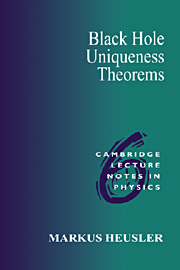Book contents
- Frontmatter
- Contents
- Preface
- 1 Preliminaries
- 2 Spacetimes admitting Killing fields
- 3 Circular spacetimes
- 4 The Kerr metric
- 5 Electrovac spacetimes with Killing fields
- 6 Stationary black holes
- 7 The four laws of black hole physics
- 8 Integrability and divergence identities
- 9 Uniqueness theorems for nonrotating holes
- 10 Uniqueness theorems for rotating holes
- 11 Scalar mappings
- 12 Self–gravitating harmonic mappings
- References
- Index
5 - Electrovac spacetimes with Killing fields
Published online by Cambridge University Press: 13 March 2010
- Frontmatter
- Contents
- Preface
- 1 Preliminaries
- 2 Spacetimes admitting Killing fields
- 3 Circular spacetimes
- 4 The Kerr metric
- 5 Electrovac spacetimes with Killing fields
- 6 Stationary black holes
- 7 The four laws of black hole physics
- 8 Integrability and divergence identities
- 9 Uniqueness theorems for nonrotating holes
- 10 Uniqueness theorems for rotating holes
- 11 Scalar mappings
- 12 Self–gravitating harmonic mappings
- References
- Index
Summary
In this chapter we consider self–gravitating electromagnetic fields which are invariant under the action of one or more Killing fields. As an application, we present the derivation of the Kerr–Newman metric in the last section.
In the first section we introduce the electric and magnetic 1–forms, E = –iKF and B = iK * F, which can be defined in terms of the electromagnetic field tensor (2–form) F and a Killing field K. We also express the stress–energy tensor in terms of K, E and B. We then focus on the case where spacetime admits two Killing fields, k and m, say, and establish some algebraic identities between their associated electric and magnetic 1–forms.
The invariance conditions for electromagnetic fields are introduced in the second section. The homogeneous Maxwell equations imply the existence of a complex potential, Λ, which can be as-sociated with E and B if the Killing field K acts as a symmetry transformation on F. In terms of Λ, the remaining Maxwell equations reduce to one complex equation for ΔΛ, involving the twist, ω, and the norm, N, of the Killing field. In the Abelian case, to which we restrict our attention in this chapter, the presence of gauge freedom does not require a modified invariance concept for F. In contrast, the symmetry conditions must be reexamined if one deals with arbitrary gauge groups (see, e.g., Forgács and Manton 1980, Harnad et al. 1980, Jackiw and Manton 1980, Brodbeck and Straumann 1993, 1994, Heusler and Straumann 1993b).
- Type
- Chapter
- Information
- Black Hole Uniqueness Theorems , pp. 56 - 83Publisher: Cambridge University PressPrint publication year: 1996

